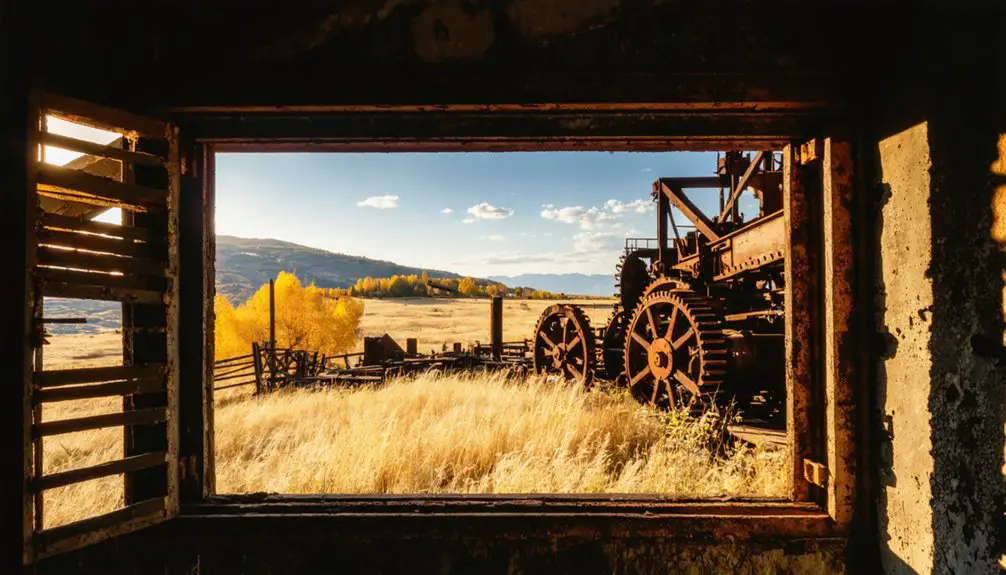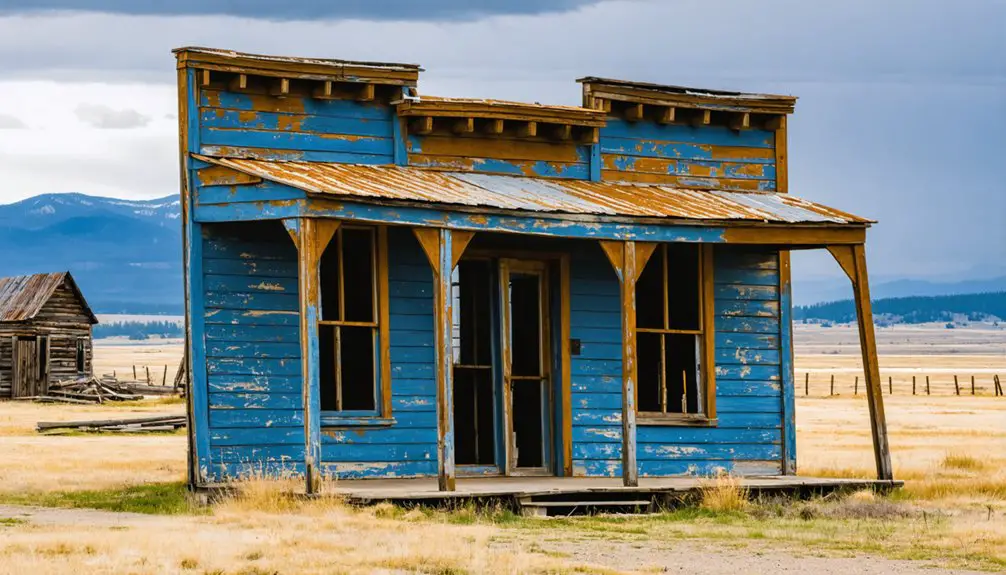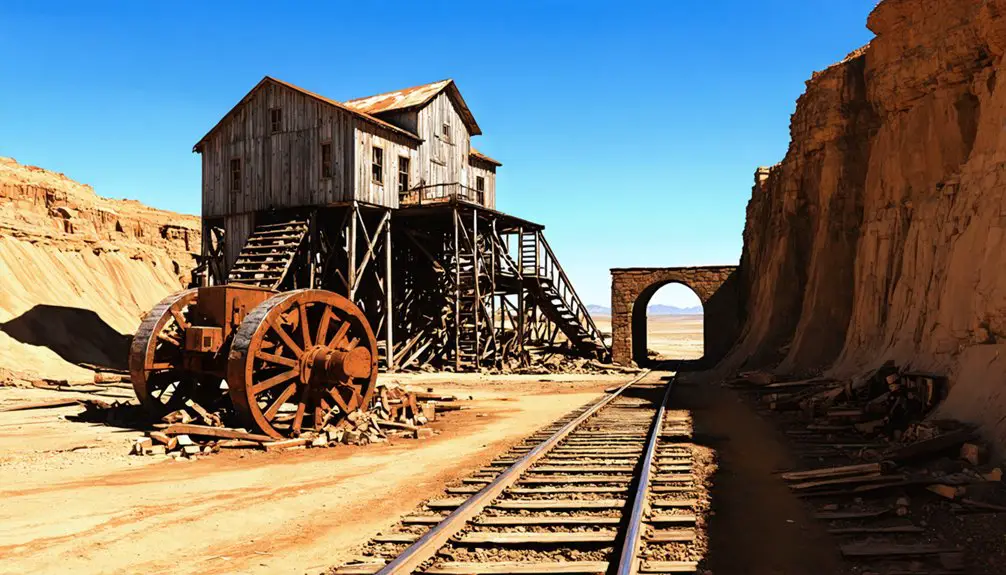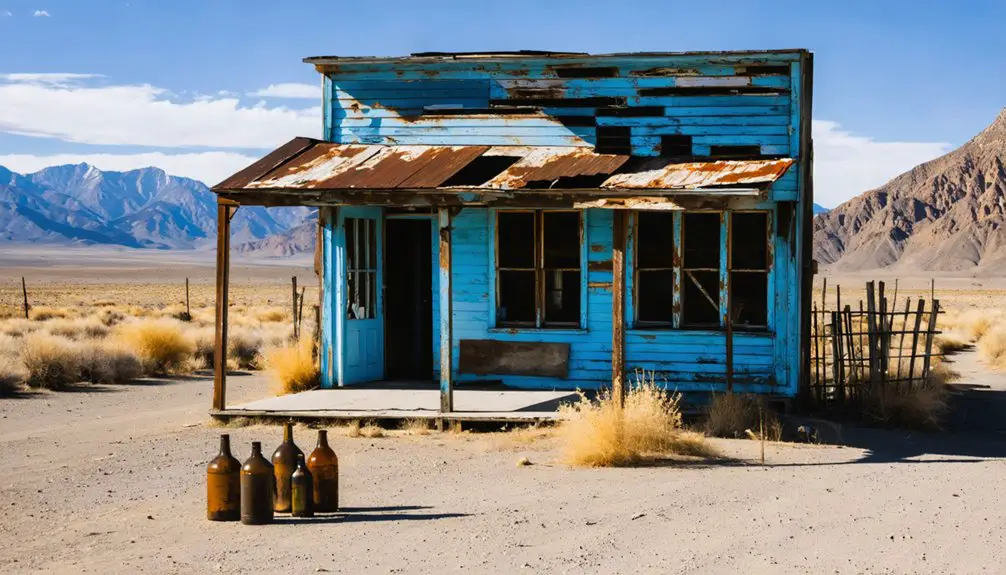You’ll find Hassel nestled in Montana’s Elkhorn Mountains, where gold strikes in 1866 launched this bustling mining camp. Originally named Saint Louis, the town reached its peak between 1898-1910, producing over $5 million in precious metals. Today, you can explore the haunting remnants of its mining heritage, including a two-story brothel with brick smokestacks and abandoned mine shafts. The rugged mountain roads lead to countless stories of Montana’s golden frontier.
Key Takeaways
- Hassel was established as Saint Louis mining camp in 1875, later renamed, and became part of Montana’s lucrative Hecla Mining District.
- The town’s peak production between 1898-1910 yielded $5 million in precious metals, primarily through gold mining operations.
- A prominent two-story brothel with surviving brick smokestacks remains one of the main architectural features in this ghost town.
- The site produced 80,300 ounces of gold valued at $2,150,000 through various mining methods from basic placer to underground operations.
- Located in a remote mountain setting, Hassel is now accessible via rugged roads and features abandoned mine shafts and deteriorating structures.
The Rise of a Montana Mining Frontier
As Montana’s initial gold rush waned in the 1870s, the territory’s mining industry underwent a dramatic transformation toward silver extraction, particularly around Butte.
Montana’s mining fortunes shifted dramatically from gold to silver in the 1870s, with Butte emerging as a key extraction hub.
You’ll find that this silver boom sparked a massive mining migration, drawing workers and investors from across the globe to Montana’s western frontier.
When Congress mandated active mining claims in 1874, prospectors rediscovered rich silver veins in abandoned sites, breathing new life into the region.
Towns like Granite, Castle, Philipsburg, and Hecla emerged as thriving silver mining communities.
The arrival of competing railroads accelerated this growth, connecting Montana’s mineral wealth to national markets.
Virginia City exemplified this rapid transformation, expanding from a rustic camp to a sophisticated town of 5,000 residents, complete with false-front businesses and high-style homes that reflected the territory’s newfound prosperity.
The Fort Benton trading post became a crucial supply hub for mining operations, facilitating commerce between miners and eastern markets.
By the late 1860s, hydraulic mining techniques revolutionized gold extraction in the region, using pressurized water to wash away dirt and recover precious metals more efficiently.
Gold Discovery and Early Mining Days
You’ll find the origins of Hassel’s gold rush in the early 1860s, when prospectors first discovered placer gold in the creek beds near what would become the town.
Around 1865, miners identified the area’s first lode deposits of gold, silver, and lead, leading to more extensive mining operations that would eventually yield over 68,000 ounces of gold through 1959. Similar to Gold Creek prospectors, early miners survived in difficult conditions while pursuing their dreams of striking it rich.
The initial mining methods were brutally simple – you’d have seen miners using basic tools like kitchen pans and shovels to extract loose gold from the creeks, before operations expanded to include more sophisticated hard rock mining techniques. The introduction of dredges in the 1890s revolutionized placer mining operations across Montana, allowing miners to process larger volumes of material more efficiently.
Early Gold Rush Era
While small amounts of placer gold emerged from Montana Territory’s gravels in the early 1860s, the discovery at Gold Creek in 1852 marked one of the region’s earliest documented finds.
The real excitement began in 1862 when prospectors struck gold at Grasshopper Creek, establishing the mining community of Bannack and releasing a flood of fortune seekers into the territory. Today, visitors can explore the well-preserved buildings as Bannack State Park.
You’ll find that Hassel’s story fits into this broader rush, though it wasn’t among the earliest discoveries. The mine was situated at 5,200 feet elevation in Broadwater County, making it a challenging but viable operation.
The area’s potential became clear between 1864 and 1904, when placer mining and lode operations produced about $850,000 in gold.
While larger strikes at Alder Gulch, Last Chance Gulch, and Butte overshadowed Hassel’s output, the district’s mixed deposits of gold, copper, lead, and zinc helped sustain the small but determined mining camp.
Indian Creek’s First Strike
When Frank Heald, John Cull, and their Empire Mining Company associates discovered gold near the west fork of Indian Creek in March 1866, they sparked a new chapter in Montana Territory’s mining history.
Their discovery expanded Montana’s gold rush eastward into the Elkhorn Mountains, where complex fault systems had created rich mineral deposits.
You’ll find their legacy in the impressive early production numbers – by 1871, placer operations had yielded $50,000 in gold (about 2,370 ounces).
The strike attracted miners from established goldfields across Montana, who worked the rich auriferous pyrite veins and placer deposits along Indian Creek.
This mining district, connected to the broader Radersburg and Weasel Creek zones, would eventually produce $17 million in metals, with gold accounting for three-quarters of that wealth. The area’s success continued through multiple periods, with lode mining until 1957 providing consistent production for the Park District.
Mining Methods Transform Hassel
The discovery of gold in Hassel marked the beginning of a complex evolution in mining methods that would shape the region’s development.
You’ll find that early miners first employed basic placer techniques in the 1860s, using sluice boxes to separate gold from stream gravels. As surface deposits depleted, operations evolved toward more sophisticated approaches.
The transformation of Hassel’s mining industry included these key developments:
- Initial placer mining using simple sluicing and panning (1861-1862)
- Advanced hydraulic methods with improved sluice systems
- Shift to lode advancements through underground mining (1929-1956)
Your understanding of Hassel’s mining heritage isn’t complete without recognizing how the Marietta mine exemplified this evolution, contributing to the town’s total production of 80,300 ounces of gold valued at $2,150,000.
Life in a Booming Mining Camp
During Hassel’s peak years between 1898 and 1910, life in this Montana mining camp revolved around the bustling activity of Indian Creek’s gold operations, which yielded approximately $5 million in precious metal.
You’d find camp camaraderie thriving along the main street, where miners gathered after long shifts at the Diamond Hill Stamp Mill or underground shafts. Social gatherings often centered around the two-story brothel, while the post office served as a crucial link to the outside world. Mining operations continued until 1946 before eventually ceasing.
You would have lived in one of the simple cabins scattered throughout town, braving harsh winters and muddy springs on the difficult access road. The Apollo Mining Co. Mine continues operations to this day, preserving a link to the town’s mining heritage.
Despite the town’s various name changes – from Saint Louis to Knoxville, Placerville, and Florence City – the community maintained its rugged spirit until Hassel became its final identity in 1895.
Diamond Hill Stamp Mill Legacy

Built in the early 1890s, Diamond Hill Mining Company‘s ambitious stamp mill brought modern industrial capacity to the Indian Creek district with its impressive 40-stamp operation.
You’ll find this pioneering facility showcased cutting-edge mining technology of its time, powered by electricity from Crow Creek’s hydroelectric plant.
Despite its technological advances, the mill faced critical challenges:
- Water supply shortages forced early operational shutdowns
- Total production reached only $500,000 by 1900
- The facility was ultimately dismantled and moved to Pony, Montana
While Diamond Hill’s legacy of innovation in mining technology proved short-lived, you can still trace its impact through the remnants of flumes and power systems that once transformed this rugged terrain. Similar to the Bi-Metallic Mining Company founded in 1881, Diamond Hill represented the era’s ambitious mining ventures in Montana.
The mill’s brief existence marks a pivotal chapter in Hassel’s evolution from boom town to ghost town.
Historical Name Changes and Development
Originally established as Saint Louis mining camp following an 1875 gold discovery, Hassel emerged from Montana’s rugged terrain as part of the greater Hecla Mining District. The evolution of the town’s name significance reflected the shifting dynamics of local mining interests, as Saint Louis camp transformed into Hassel while the settlement expanded beyond its initial prospecting roots.
You’ll find that Hassel’s community identity developed around its mining foundation, with rapid construction of essential structures including cabins, a post office, and various commercial establishments.
The town’s growth pattern followed the typical Montana mining camp template – quick, practical buildings erected to serve immediate needs. While the settlement lacked formal planning, it grew organically to support the burgeoning mining operations that defined its existence.
Architecture and Town Infrastructure

Walking through Hassel’s remnants today, you’ll find a main street that once served as the town’s commercial spine, anchored by the prominent two-story brothel with its surviving brick smokestacks.
You can still see evidence of the town’s wooden construction methods in the rotted floors and staircases, which used locally-sourced Montana timber built without permanent foundations for quick assembly.
The town’s practical layout positioned essential structures like the post office and residential cabins within walking distance of the mining operations and railroad tracks, creating an efficient if temporary settlement typical of Montana’s mining camps.
Main Street Layout
The heart of Hassel’s infrastructure centered on its Main Street, a critical artery that connected the town’s essential buildings and mining operations.
You’ll find the remains of various structures that once buzzed with community interactions, including a prominent two-story brothel with its distinctive porch and front staircase.
Here’s what made Main Street the town’s lifeline:
- Essential services like the post office were within walking distance of residential cabins
- Large porches and staircases created spaces for social gatherings and business dealings
- The street provided direct access to nearby mine shafts and abandoned rail lines
The road’s condition often challenged travelers, especially during winter months and spring runoff, reflecting the rugged nature of this frontier mining settlement.
Building Materials Used
Construction materials in Hassel reflected standard practices of 19th-century Montana mining towns, with wood serving as the primary building component.
You’ll find local timber framing throughout the main structures, including the notable brothel, though minimal wood preservation techniques led to extensive deterioration over time.
While wood dominated the landscape, masonry techniques appear in the surviving brick or stone chimneys, particularly the two that still stand at the brothel.
Buildings typically lacked proper foundations, and you’ll notice the floors and porches were made from simple wood planks, most now rotted from weather exposure.
Roofing originally consisted of wooden shingles or basic metal sheets, though little remains intact today.
Mining infrastructure utilized similar wooden construction for shacks, shaft supports, and track trestles.
Remnants Still Standing
Standing prominently among Hassel’s deteriorating structures, the two-story brothel remains the town’s most notable architectural survivor, complete with its original basement and twin brick chimneys.
While time has claimed most of the town’s wooden elements, you’ll find several significant remnants that paint a picture of this once-bustling mining community.
Key structures you can still explore include:
- The post office ruins, marking Hassel’s former communication hub
- Scattered mine shafts and abandoned shacks throughout the site
- Main street remnants with original train tracks
The brothel’s preservation stands as a representation of the town’s colorful past, with its chimney significance extending beyond mere functionality – these vertical markers serve as silent sentinels of Hassel’s heyday.
You’ll also find clustered cabin foundations and deteriorating roadways throughout the site.
Mining Methods Through the Years

As gold fever swept through Montana’s mining districts in the mid-1800s, Hassel’s earliest prospectors relied on basic placer mining techniques to extract precious metals from stream sediments.
You’d have found them panning and sluicing alongside streams, searching for glints of gold in the Elkhorn Mountains’ rich deposits.
When surface gold became scarce, operations evolved dramatically. Hydraulic mining blasted hillsides with powerful water jets, while massive dredging techniques transformed the landscape by creating artificial ponds to process larger volumes of earth.
These methods, though efficient, left lasting environmental impact. The geological formations of the area, with their complex fault systems and auriferous pyrite veins, demanded increasingly sophisticated ore processing and mining machinery.
Safety advancements gradually improved working conditions, though early miners faced considerable risks in their pursuit of wealth.
Present-Day Ghost Town Experience
While mining operations have long ceased, today’s visitors to Hassel encounter a remote mountain settlement frozen in time.
Frozen in Montana’s rugged mountains, Hassel stands as a silent testament to the bygone era of frontier mining.
You’ll find this ghost town west of Townsend, Montana, accessible by a rugged mountain road that demands a capable vehicle.
Your ghost town exploration reveals historic structures including a two-story brothel with surviving smokestacks and remnants of the town’s original layout.
For the safest and most rewarding experience:
- Visit during summer months when road conditions are ideal
- Stay alert around deteriorating structures and mine shafts
- Bring appropriate gear for rough terrain exploration
You can walk among abandoned mine shafts, old train tracks, and weathered buildings within minutes of each other, though visitor safety requires careful navigation of unstable floors and decaying porches.
Frequently Asked Questions
How Many People Lived in Hassel During Its Peak Population Years?
Where there’s smoke, there’s fire, and while you can’t pinpoint Hassel’s exact peak population during its mining boom, you’d find it likely reached between 200-300 residents in its heyday.
What Happened to the Families Who Lived There After Mining Declined?
You’ll find these families scattered after economic struggles forced them out, with most relocating to larger Montana towns for work, while others turned to ranching or farming in nearby communities for survival.
Were There Any Notable Crimes or Lawlessness Incidents in Hassel?
While surrounding Montana mining towns saw wild vigilante justice, you won’t find documented crime history or major law enforcement incidents specifically in Hassel, though typical mining-era vices like gambling likely occurred.
Did Any Famous Historical Figures Ever Visit or Stay in Hassel?
You won’t find any famous visitors in Hassel’s history books. The town’s historical significance centers on local mining operations and pioneers like Joseph E. Hassel, rather than celebrity appearances or notable figures.
What Natural Disasters or Significant Accidents Occurred in Hassel’s Mining Operations?
Like a dark cloud over its legacy, you’ll find limited documented records of major mining accidents or natural disasters in Hassel’s operations, though small-scale incidents likely occurred during its active mining years.
References
- https://thenathanblackburn.wordpress.com/2015/03/28/ghost-towns-of-montana/
- https://www.legendsofamerica.com/mt-ghosttowns/
- http://www.travelmt.com/mt_sites_10363_Hassel+(St.+Louis).html
- https://www.mountain-home.com/blog/vacation-planning/guide-montana’s-ghost-towns
- http://stoneydale.com/product_info.php?products_id=324
- https://mhs.mt.gov/education/textbook/chapter6/Chapter6.pdf
- https://virginiacitymt.com/Preservation/Area-History
- https://en.wikipedia.org/wiki/History_of_Montana
- https://westernmininghistory.com/state/montana/
- https://www.blm.gov/sites/default/files/docs/2021-07/THE ROAD TO GARNET’S GOLD (002).pdf



